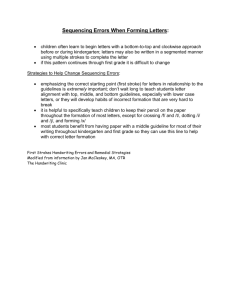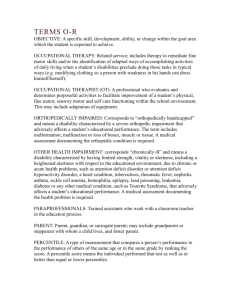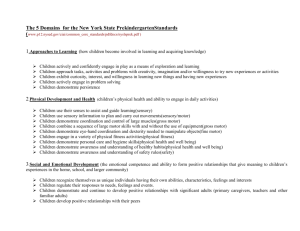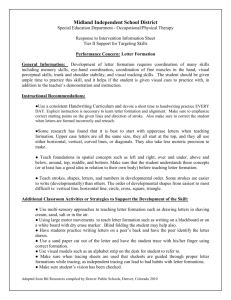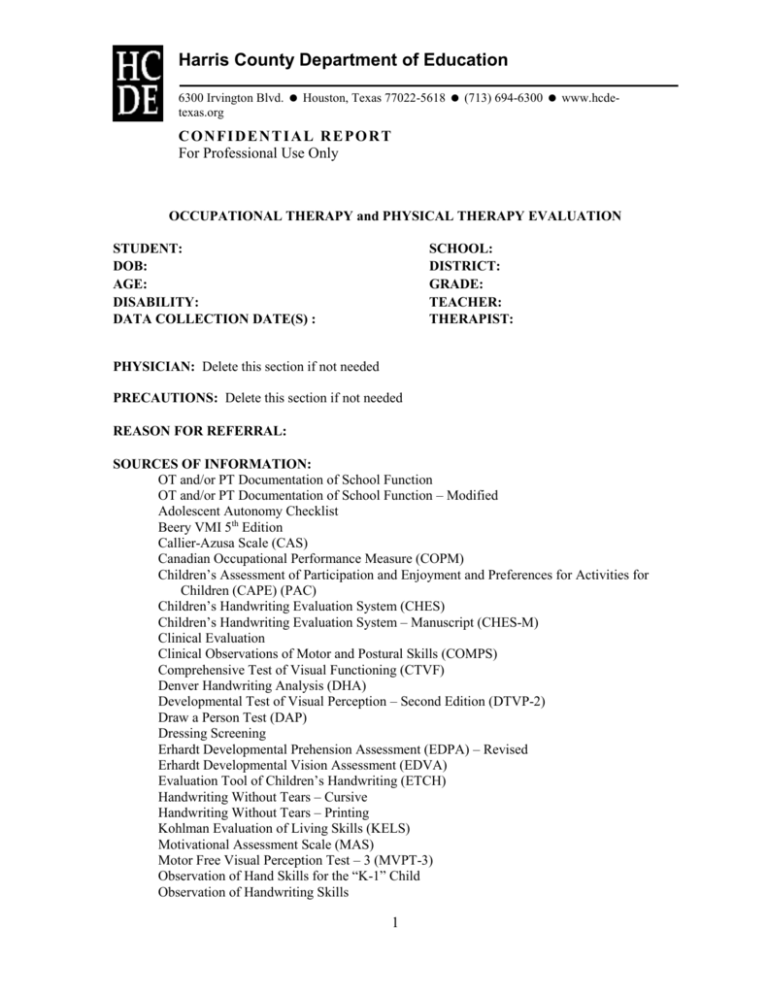
Harris County Department of Education
6300 Irvington Blvd. Houston, Texas 77022-5618 (713) 694-6300 www.hcdetexas.org
C O N FI D E N T I A L R E PO R T
For Professional Use Only
OCCUPATIONAL THERAPY and PHYSICAL THERAPY EVALUATION
STUDENT:
DOB:
AGE:
DISABILITY:
DATA COLLECTION DATE(S) :
SCHOOL:
DISTRICT:
GRADE:
TEACHER:
THERAPIST:
PHYSICIAN: Delete this section if not needed
PRECAUTIONS: Delete this section if not needed
REASON FOR REFERRAL:
SOURCES OF INFORMATION:
OT and/or PT Documentation of School Function
OT and/or PT Documentation of School Function – Modified
Adolescent Autonomy Checklist
Beery VMI 5th Edition
Callier-Azusa Scale (CAS)
Canadian Occupational Performance Measure (COPM)
Children’s Assessment of Participation and Enjoyment and Preferences for Activities for
Children (CAPE) (PAC)
Children’s Handwriting Evaluation System (CHES)
Children’s Handwriting Evaluation System – Manuscript (CHES-M)
Clinical Evaluation
Clinical Observations of Motor and Postural Skills (COMPS)
Comprehensive Test of Visual Functioning (CTVF)
Denver Handwriting Analysis (DHA)
Developmental Test of Visual Perception – Second Edition (DTVP-2)
Draw a Person Test (DAP)
Dressing Screening
Erhardt Developmental Prehension Assessment (EDPA) – Revised
Erhardt Developmental Vision Assessment (EDVA)
Evaluation Tool of Children’s Handwriting (ETCH)
Handwriting Without Tears – Cursive
Handwriting Without Tears – Printing
Kohlman Evaluation of Living Skills (KELS)
Motivational Assessment Scale (MAS)
Motor Free Visual Perception Test – 3 (MVPT-3)
Observation of Hand Skills for the “K-1” Child
Observation of Handwriting Skills
1
Therapy Evaluation
NAME:
DISTRICT:
Observation of Written Expression Skills
Occupational Therapy Psychosocial Assessment of Learning (OT PAL)
Peabody Developmental Motor Scales – 2 (PDMS-2)
Pediatric Evaluation of Disability Inventory (PEDI)
Preschool Visual Motor Integration Assessment (PVMIA)
The Print Tool
Quick Neurological Screening Test – Revised (QNST-II)
School Function Assessment (SFA)
Self-Help Skills Screening
SensoriMotor Performance Analysis (SPA)
Sensory Integration Inventory-Revised
Sensory Processing Observations
Sensory Processing Measure
Sensory Profile
Sensory Profile – Adolescent/Adult
Sensory Profile – Infant/Toddler
Slosson Visual-Motor Performance Test (S-VMPT)
Spatial Awareness Skills Program Test (SASP)
Test of Auditory-Perceptual Skills (TAPS)
Test of Gross Motor Development
Test of Pictures/Forms/Letters/Numbers
Test of Visual-Motor Skills – Upper (TVMS-U)
Test of Visual-Motor Skills – Revised – Lower (TVMS-R-L)
Test of Visual Perception Skills – Lower (TVPS-L)
Test of Visual Perception Skills – Upper (TVPS-U)
Review of Student Folder
Parent Interview
Student Interview
Teacher Interview(s)
COMPLIANCE: Compliant Not Compliant Explain if not compliant
BACKGROUND DATA:
Student has a disability/diagnosis of
Previous services/history
How disability affects learning and participation
How behavior affects participation
Child's program and supports consist of
CURRENT SCHOOL OBSERVATIONS:
Present level of academic achievement and functional performance
Successful modifications currently in place
Adaptive equipment and/or assistive technology in IEP - (used or unused?) (home and/or school?)
TEST RESULTS:
Adolescent Autonomy Checklist
The Adolescent Autonomy Checklist is designed to identify the student’s knowledge of their illness
and/or disability skills at home, health care skills, community skills and leisure skills. This
information may be helpful in the transition process.
2
.
Therapy Evaluation
NAME:
DISTRICT:
Summarize results
Beery VMI 5th Edition
(by Keith Beery, Ph.D.)
The Beery VMI 5th Edition is designed to assess the extent to which individuals can integrate their
visual and motor abilities.. The VMI is not timed. It is standardized for normal children between the
ages two years and adult. Completion of the test will provide a standard score and percentile.
Supplemental, standardized Visual Perception and Motor Coordination tests are available as a
means for statistically assessing visual and motor contributions to the VMI performance.
VMI
Visual component
Motor Component
Standard Score: scores
Standard Score: scores
Standard Score: scores
Percentile: scores
Percentile: scores
Percentile: scores
Scaled Score: scores
Scaled Score: scores
Scaled Score: scores
Callier-Azusa Scale (CAS)
(created at the Callier Center for Communication Disorders at the University of Texas/Dallas)
The Callier-Azusa Scale (CAS) is an instrument designed for the assessment of deaf-blind, multihandicapped children. Administration of the CAS is based on observation of behaviors which
typically occur in conjunction with classroom activities.
Motor Development
Postural Control
Locomotion
score
score
months
months
Fine Motor
Visual Motor
score
score
months
months
Perceptual Development
Vision
score
Auditory
score
months
months
Fine Motor
Tactile
score
score
months
months
Daily Living Skills
Dressing
Personal Hygiene
months
months
Feeding
Toileting
score
score
months
months
score
score
months
months
Environmental score
months
score
score
Cognition, Communication, and Language
Cognition
score months
Expressive
Receptive
score months
Speech
Social Development
Adults
Peers
score
score
months
months
Canadian Occupational Performance Measure (COPM)
(by Mary Law, Ph.D., Sue Baptiste, M.H.Sc., Anne Carswell, Ph.D., Mary Ann McColl, Ph.D.,
Helene Polatajko, Ph.D., Nancy Pollock, M.Sc.)
The Canadian Occupational Performance Measure (COPM) is a standardized measure designed to
detect change in a client’s self-perception of occupational performance over time. It can be used with
persons with a wide variety of disabilities and across all developmental stages.
Summarize results
3
.
Therapy Evaluation
NAME:
DISTRICT:
Children’s Assessment of Participation and Enjoyment and Preferences for Activities for
Children (CAPE) (PAC)
(Gillian King, Mary Law, Susanne King, Patricia Hurley, Peter Rosenbaum, Steven Hanna, Marilyn
Kertoy and Nancy Young, 2005)
The CAPE and PAC may be used independently or together for clients between the ages of
6 and 21 years. The CAPE explores an individual’s day-to-day participation for the purpose of
intervention planning or measuring outcomes. The PAC assesses an individual’s preference
for activities. Activity types addressed in both measures include: recreational, physical, social, skillbased, and self-improvement.
Summarize results
Children’s Handwriting Evaluation Scale-CHES
(by Texas Scottish Rite Hospital for Crippled Children)
The evaluation tool enables a quick appraisal of deficient areas in cursive handwriting for 3rd
through 8th grades. Rate and quality are evaluated based on unrehearsed copying of a short story.
Quality is judged according to five criteria: letter form, slant, rhythm, spacing and general
appearance.
Rate:
Standard Score
score
Quality:
Percentile
score
90 –100 %
76 – 90 %
25 – 75 %
9 – 24 %
8% and Below
Sum of Points
score
5
4
3
2
0-1
Very Good
Good
Satisfactory
Poor
Very Poor
Very Good
Good
Satisfactory
Poor
Very Poor
Children’s Handwriting Evaluation Scale for Manuscript (CHES-M)
(by Texas Scottish Rite Hospital for Crippled Children)
The CHES-M is an evaluation tool that enables a quick appraisal of deficient areas in manuscript
handwriting for 1st and 2nd graders. The test gives a percentile score for rate and quality based on
unrehearsed copying of a short story.
Rate:
Standard Score
score
Raw Score
Quality score
Percentile
score
Standard Score
score
Percentile
score
4
.
Level of Function
> 85 %
15 – 85 %
< 15 %
Good
Satisfactory
Poor
Classification
80 – 100
50 – 70
10 – 40
Good
Satisfactory
Poor
Therapy Evaluation
NAME:
DISTRICT:
Clinical Evaluation
Summarize results
Clinical Observations of Motor and Postural Skills (COMPS)
(by Brenda N. Wilson, M.S., OT(C), Nancy Pollock, M. Sc., OT(C), Bonnie J. Kaplan, Ph.D., & Mary
Law, Ph.D., OT(C))The Clinical Observations of Motor and Postural Skills (COMPS) is a screening
tool for the identification of motor problems in 5- to 9- year old children.
Weighted Score
Slow Motion
score
Rapid Forearm Rotation
score
Finger-Nose Touching
score
Prone Extension
score
ATNR
score
Supine Flexion
score
Total:
score
Minus Adjustment:
score
Weighted Total Score:
score
Comprehensive Test of Visual Functioning (CTVF)
(by Sue L. Larson, Evelyn Buethe, & Gary J. Vitali)
The Comprehensive Test of Visual Functioning (CTVF) evaluates visual-perceptual functioning. It is
designed to give general information about overall visual perceptual processing essential for
educational and clinical programming.
Total Visual Functioning Standard Score:
score
Summarize results
Denver Handwriting Analysis (DHA)
(by Peggy L. Anderson, Ph.D.)
The Denver Handwriting Analysis (DHA) is an informal, criterion-referenced cursive handwriting
scale designed for use with students in grades three through eight. The scale consists of subtest;
near-point copying, writing the alphabet, far-point copying, manuscript-cursive transition and
dictation:
Total: Parts I – III
score % Mastery Level
Part IV: Manuscript Cursive Transition
score % Mastery Level
Part V: Dictation
score & Mastery Level
Developmental Test of Visual Perception – Second Edition (DTVP-2)
(By Donald D. Hammill, Nils A. Pearson, and Judith K. Voress)
The DTVP-2 is a battery of subtests that measure different but interrelated visual perceptual and
visual motor abilities. The battery was designed for use with children ages 4 through 10. The
subtests include eye-hand coordination, position in space, copying, figure ground, spatial relations,
visual closure, visual-motor speed and form constancy.
5
.
Therapy Evaluation
NAME:
DISTRICT:
Quotients
Percentiles
General Visual Perception
score
score %
Motor-Reduced Visual Perception
score
score %
Visual-Motor Integration
score
score %
Draw A Person (DAP)
(by Jack A. Naglieri)
The Draw A Person (DAP) was designed to provide a nonverbal, nonthreatening means of evaluating
developmental status. It can be used with any age or disability.
Drawing
Man
Woman
Self
Total
Standard Score
score
score
score
score
Percentile
score %
score %
score %
score %
Standard Scores
(± score) score to score
(± score) score to score
(± score) score to score
(± score) score to score
Percentiles
score to score %
score to score %
score to score %
score to score %
score % Confidence Interval
Total Test Classification: score
Dressing Screening
The Dressing Screener identifies developmental levels specifically in the area of dressing.
Summarize results
Erhardt Developmental Prehension Assessment –Revised (EDPA)
(by Rhoda P. Erhardt, M.S., OTR, FAOTA)
The Erhardt Developmental Prehension Assessment Revised (EDPA) measures components of arm
and hand development in children of all ages and cognitive levels with developmental delays,
cerebral palsy, and multiple disabilities.
Developmental Levels
Section 1. Primary Involuntary Arm-Hand Patterns
Section 2. Primarily Voluntary Movements
Section 3. Pre-Writing Skills
Left Hand
Right Hand
score months
score months
score months
score months
years
score
score years
Erhardt Developmental Vision Assessment (EDVA)
(by Rhoda P. Erhardt, M.S., OTR, FAOTA)
The Erhardt Developmental Vision Assessment (EDVA) was designed to measure the motor
components of visual development in children of all ages and cognitive levels with developmental
delays, cerebral palsy, and multiple disabilities.
Periodic Blink:
Section 1. Primarily Involuntary Visual Patterns (Reflexive)
Section 2. Primarily Voluntary Eye Movements (Cognitively-directed)
6
.
score
score
score
per minute
months
months
Therapy Evaluation
NAME:
DISTRICT:
Evaluation Tool of Children’s Handwriting (ETCH)
(by Susan J. Amundson, MS, OTR/L)
The Evaluation Tool of Children’s Handwriting (ETCH) looks at many tasks which occur in the
classroom setting, including writing the alphabet in upper and lower cases from memory, writing
numerals, copying from both a nearby model and a distant model, writing from dictation and
composing a sentence. The ETCH has both a manuscript and cursive component.
Manuscript
Words
Letters
Numerals
Cursive
Words
Letters
Numerals
score
score
score
score
score
score
Handwriting without Tears-Cursive
(by Jan Olsen, OTR)
Handwriting without Tears-Cursive is an evaluation tool that identifies cursive abilities and areas of
concern. It addresses components such as posture, pencil grip, letter formation, and letter
connections. It targets school-age children with a variety of disabilities and developmental stages.
Summarize results
Handwriting without Tears-Printing
(by Jan Olsen, OTR)
Handwriting without Tears-Printing is an evaluation tool that identifies manuscript abilities and
areas of concern. It addresses components such as posture, pencil grip, spacing, size, and position in
space. It targets school-age children with a variety of disabilities and developmental stages.
Summarize results
The Kohlman Evaluation of Living Skills (KELS)
(by Linda Kohlman Thomson)
The Kohlman Evaluation of Living Skills (KELS) is evaluation designed to determine a person’s
ability to perform basic living skills. The following five areas are tested: Self-Care, Safety and
Health, Money Management, Transportation and Telephone, and Work and Leisure).
Summarize results
Motivation Assessment Scale (MAS)
(by V. Mark Durand, Ph.D. & Daniel B. Crimmins, Ph.D.)
The Motivation Assessment Scale (MAS) was developed to help explain why inappropriate behaviors
may be occurring. It weighs the influence of social attention, tangibles, escape, and sensory
consequences on problem behavior.
Summarize results
7
.
Therapy Evaluation
NAME:
DISTRICT:
Motor-Free Visual Perception Test-3 (MVPT-3)
(by Ronald P. Colarusso, EdD, Donald D. Hammill, EdD)
The Motor-Free Visual Perception Test (MVPT-3) is a test of visual perception, which avoids any
motor involvement. The MVPT-3 is standardized on normal children aged four years through eleven
years.
Standard Score:
score
Observation of Hand Skills of the “K-1” Child
(by Mary Benbow MS, OTR)
Observation of Hand Skills of the “K-1” Child is a checklist of components necessary for successful
handwriting.
Summarize results
Observation of Handwriting Skills
(compiled by Amanda Letsos, OTR)
This tool was compiled to look at the functional handwriting performance of the student in the
classroom, identify specific areas which could impact handwriting or academic performance and
provide information for future comparison.
Summarize results
Observation of Written Communication Skills
(compiled by Amanda Letsos, OTR)
This tool allows the evaluator to review rate of production with handwriting and keyboarding skills.
A sixty second sample is obtained and then calculated to determine the gross words per minute
(GWPM) for each of the areas. In addition, spelling skills are observed as well as the efficiency of
writing.
Alphabet
Sentence Copy
Dictated Sentence
Composed Sentence
Recorded Sentence
Handwriting
score GWPM
score GWPM
score GWPM
score GWPM
score GWPM
Written Language Traits- Summarize results
Spelling- Summarize results
8
.
Keyboarding
score GWPM
score GWPM
score GWPM
score GWPM
score GWPM
Therapy Evaluation
NAME:
DISTRICT:
Occupational Therapy Psychosocial Assessment of Learning (OT PAL)
(by Sally Townsend, Paula D. Carey, Nancy L Hollins, Christine Helfrich, Melinda Blondis, Amanda
Hoffman, Lara Collins, Julie Knudson, and Angela Blackwell)
The Occupational Therapy Psychosocial Assessment of Learning (OT PAL) is a tool designed to
examine environmental factors to determine the best “fit” between a particular child and his/her
environment. It targets students between the ages of 6-12 years old who are experiencing difficulty
meeting functional expectations and roles in the classroom.
Summarize results
Peabody Developmental Motor Scales-2 (PDMS-2)
(by M. Rhonda Folio & Rebecca R.. Fewell)
The Peabody Developmental Motor Scales-Second Edition (PDMS-2) is a standardized test that
identifies motor development in children from birth through 6 years.
Reflexes
Stationary
Locomotion
Object Manipulation
Grasping
Visual-Motor Integration
Percentile
score
score
score
score
score
score
Standard Score
score
score
score
score
score
score
Pediatric Evaluation of Disability Inventory (PEDI)
(by: Stephen M. Haley, Ph.D., P.T., Wendy J. Coster, Ph.D., OTR/L, Larry H. Ludlow, Ph.D.,Jane T.
Haltiwanger, MA, Ed.M., Peter J. Andrellos, Ph.D.)
The Pediatric Evaluation of Disability Inventory (PEDI) was designed to provide a comprehensive
assessment of functional skill development and the level of independent performance of functional
activities in the child’s environment. Items were selected to sample functional skill development in
three major domains: self-care, mobility, and social function for children between the ages of 6
months and 7.5 years.
Domains
Self-Care
Mobility
Social Function
Self-Care
Mobility
Social Function
Normative
Standard Score
score
score
score
score
score
score
Functional Skills
Functional Skills
Functional Skills
Caregiver Assistance
Caregiver Assistance
Caregiver Assistance
Scaled
Score
score
score
score
score
score
score
Preschool Visual Motor Integration Assessment (PVMIA)
(by Gertrude Deitchman, M.A., OTR & Cordelia Puttkammer, M.Ed., OTR/l, FAOTA
The Preschool Visual Motor Integration Assessment (PVMIA) is an assessment designed to
investigate the visual motor integration skills of the 3 ½ to 5 ½ year old population. It is designed to
identify deficits, and to ascertain the areas on which any necessary intervention should be focused.
9
.
Therapy Evaluation
NAME:
DISTRICT:
Drawing Subtest
Block Patterns Subtest
Combined Total
Standard Score
score
score
score
Stanine
score
score
score
Percentile Range
score
score
score
The Print Tool
(Jan Olsen, 2005)
The Print Tool™ is used to evaluate printing skills. It scores eight different skill components
for capitals, lowercase letters and numbers. It is appropriate for ages 6-8+ and may be adapted for
children with special needs.
Summarize results
Quick Neurological Screening Test (2nd Revised Edition) (QNST-II)
(by Margaret C. Mutti, M.A., Nancy A. Martin, Ph.D, Harold M. Sterling, M.D., & Norma V.
Spalding, Ed.D)
The Quick Neurological Screening Test (QNST-II) is an individually administered screening
instrument designed to assess areas of neurological integration as they relate to learning. It can be
administered to children as young as five years old, as well as with older children, adolescents, and
adults.
Total Score:
Overall Category:
score
category
School Function Assessment (SFA)
(by Wendy Coster, Theresa Deeney, Jane Haltiwanger, & Stephen Haley)
The School Function Assessment (SFA) was developed for students in elementary school to assist
education team members with assessing a student’s ability to meet the functional demands in the
student’s curriculum.
The SFA provides separate measures of a student’s current level of participation in school settings,
performance of functional activities, and the supports he or she needs to perform these functional
tasks. Information can be directly linked to program planning decisions for the student assessed.
Summarize results
Self Help Skills Screening
The Self Help Skills Screening is a tool to identify specific skills in the areas of dressing, toileting,
grooming, feeding, functional mobility and wheelchair use.
Summarize results
Sensory Integration Inventory-Revised
(by Judith E. Reisman, PhD, OTR, FAOTA & Bonnie Hanschu, OTR)
The Sensory Integration Inventory-Revised, for Individuals with Developmental Disabilities is a
preliminary assessment for occupational therapy personnel who serve people with developmental
delays and disabilities. It is designed to indicate potential sensory processing issues.
Summarize results
10
.
Therapy Evaluation
NAME:
DISTRICT:
SensoriMotor Performance Analysis (SPA)
(by Eileen W. Richter, MPH, OTR, FAOTA and Patricia C. Montgomery, PhD, PT)
The Scoring Profile was designed to provide the therapist with a quantitative profile of the client’s
performance or an overview of the results that suggest patterns of performance and / or dysfunction.
Since the SPA provides a record of baseline function, quantification of scores will allow comparison
of pre- and post-test results following a therapy program. The Scoring Profile groups the
performance components of each test item according to their related sensorimotor components.
Summarize results
Sensory Processing Observations
The Sensory Processing Observations is a collection of components that may contribute and/or affect
a student’s ability to process sensory input.
Summarize results
Sensory Processing Measure (SPM)
(Main Classroom and School Environments Forms by Heather M. Kuhaneck, OTR/L, Diana A.
Henry, M.S., OTR/L and Tara J. Glennon, Ed.D., OTR/L, FAOTA; Home Form by Diane Parham,
Ph.D., OTR/L, FAOTA and Cheryl Ecker, M.A., OTR/L)
The SPM is designed to assess children in kindergarten through sixth grade (ages 5 through 12). The
test items cover a wide range of behaviors and characteristics related to sensory processing, social
participation and praxis. Each item is rated in terms of the frequency of the behavior on a 4-point
Likert-type scale. The Home Form and Main Classroom Form both yield eight norm-referenced
standard scores.
Summarize results
Sensory Profile
(by Winnie Dunn, Ph.D., OTR, FAOTA)
The Sensory Profile provides an evaluation tool for professionals to gather information from
caregivers about a child’s sensory processing characteristics that support and/or interfere with
functional performance. The test applies for children ages 5-10 or modified for 3-4 year olds, with
all types of disabilities and severity levels.
Summarize results
Sensory Profile – Adolescent/Adult
(by Winnie Dunn, Ph.D., OTR, FAOTA)
The Sensory Profile is a trait measure of sensory processing. An individual answers questions
regarding how he or she generally responds to sensation. The test applies to ages 11-65+ with all
types of disabilities and severity levels.
Summarize results
11
.
Therapy Evaluation
NAME:
DISTRICT:
Sensory Profile – Infant/Toddler
(by Winnie Dunn, Ph.D., OTR, FAOTA)
The Sensory Profile provides an evaluation tool for professionals to gather information from
caregivers about a child’s sensory processing characteristics that support and/or interfere with
functional performance. The test applies for children ages birth to three with all types of disabilities
and severity levels.
Summarize results
Slosson Visual-Motor Performance Test (S-VMPT)
(revised by Charles L. Nicholson)
The Slosson Visual-Motor Performance Test is a revision of the Slosson Drawing Coordination Test
designed by Richard L. Slosson. The S-VMPT is a screening instrument designed to identify
individuals with a visual-motor perceptual problem. The test helps identify individuals (4 years
through adult) with various forms of perceptual disorders where eye-hand coordination is involved.
Standard Score:
score
Percentile:
score %
Spatial Awareness Skills Program Test (SASP Test)
(by Jerome Rosner)
The Spatial Awareness Skills Program Test (SASP Test) is a tool to identify spatial awareness delays
that can impact academic performance.
SASP Level for Remediation:
level
Test of Auditory-Perceptual Skills (TAPS)
(by Morrison F. Gardner)
The Test of Auditory-Perceptual Skills (TAPS) is used to assess various areas of auditory-perceptual
skills in 4-12 year olds. It also offers information about ability to follow various types of directions
with accurate pronunciation of words, reasoning, immediate recall or nonsensical rote auditory
matter and discrimination of word sounds.
Auditory Number Memory Forward:
Auditory Number Memory Reversed:
Auditory Sentence Memory:
Auditory Word Memory:
Auditory Interpretation of Direction:
Auditory word Discrimination:
Auditory Processing
Standard Score
score
score
score
score
score
score
score
Auditory Perceptual
Quotient:
Percentile Rank:
Hyperactivity Index Scale:
score
score%
Classification label
12
.
Scaled Score
score
score
score
score
score
score
score
Percentile rank
score%
score%
score%
score%
score%
score%
score%
Therapy Evaluation
NAME:
DISTRICT:
Test of Pictures/Forms/Letters/Numbers/Spatial Orientation & Sequencing Skills
(by Morrison F. Gardner)
The purpose of the Test of Pictures/Forms/Letters/Numbers/Spatial Orientation &Sequencing Skills is
to determine a child’s ability to visually perceive pictures, forms, letters, and numbers in the correct
direction and to visually perceive words with the letters in the correct sequence.
Spatial Relationships (pictures)
Spatial Relationships (Forms)
Reversed Letter and Number of 2 Letters/Numbers
Reversed Letter(s) in Words
Reversed Letters from non-Reversed Letters
Reversed Numbers from non-Reversed Numbers
Letter Sequence
Standard
Scores
score
score
score
score
score
score
score
Scaled
Scores
score
score
score
score
score
score
score
Percentile
Ranks
score%
score %
score %
score %
score %
score %
score %
Test of Visual-Motor Skills-Revised (TVMS)
(by Morrison F. Gardner)
The Test of Visual-Motor Skills (TVMS) measures how well the individual translates with his hand
what he visually perceives. The TVMS is standardized for normal children/adolescents/ adults
between the ages 2 years and 40 years.
Standard Score:
score
Percentile Rank:
score %
Test of Visual-Perceptual Skills-Revised (TVPS)
(by Morrison F. Gardner)
The Test of Visual-Perceptual Skills (TVPS) is an assessment of visual perception which eliminates
the motor component. The TVPS has been standardized on students from age 4.0 years to 19 years
depending upon lower or upper level tests.
Upper / Lower Level
Overall Perceptual Quotient:
Overall Percentile Rank:
Visual Discrimination
Visual Memory
Visual-Spatial Relations
Visual Form Constancy
Scaled Scores
score
score
score
score
score
score
Visual Sequential Memory
Visual Figure-Ground
Visual Closure
Scaled Scores
score
score
score
Learning and Participation Implications:
Summarize learning and participation implications from all sources of data collected. Do not reiterate
scores; relate results to current performance, including reason for referral if there is a connection.
13
.
Therapy Evaluation
NAME:
DISTRICT:
Strengths:
1.
2.
3.
Areas Needing Support:
1.
2.
3.
Suggested Intervention:
OT and PT services: It is the professional opinion of the therapist(s), based on observation,
assessment, and interview with instructional personnel that Student's Name does does not need
therapy to benefit from his her education
The recommendations for this school year are:
OT
PT
Time
Time
Frequency
Frequency
Duration
Duration
Therapy Services
may be provided to the child or on behalf of the child
occur in environments appropriate to IEP goal(s)
(classroom, cafeteria, restroom, playground, vocational or community sites, etc.)
occur in collaboration with instructional staff to support attainment of IEP goal(s)
utilize an array of methodologies
Examples of how IEP time may be implemented
- Problem solving/developing strategies
- Modeling strategies/techniques
- Consulting with teachers, other providers or parents
- Training instructional personnel, other providers or parents
- Supporting use of assistive technology and
adaptive equipment
- Providing Home/School Programs
- Collecting data for progress
Annual Goals Needing Support:
A home/school program will or will not be provided as needed.
The Documentation of School Function is attached.
_________________________
Therapist Name, PT
Physical Therapist
Therapist Name, OTR
Occupational Therapist
Revosed 8/07
Copyright 2006 HCDE
All rights reserved.
14
.
Therapy Evaluation
NAME:
DISTRICT:
15
.

